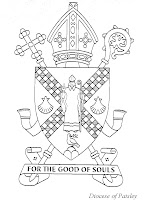'Our Lady on Saturday' is the overall title given to a series of quarterly talks at St Mary-the-Virgin, Kenton on the place of Our Lady as a focus of devotion and unity for all Christians. It is organised under the auspices of the Ecumenical Society of the Blessed Virgin Mary (ESBVM). The speakers will be drawn from across the Christian traditions and denominations. Enquiries should be directed to the parish priest. Each afternoon concludes with the saying of Evening Prayer according to the New Ecumenical Office of Mary, the Mother of Jesus.
Mary Links Calendar http://www.marylinks.org/Mary-Calendar.htm#JULY This is a daily calendar of Marian events on every day of the year. It is compiled from various web sources, and Tan Books' "Marian Feast-Day Calendar." The calendar reveals the incredible diversity of Marian celebrations across the centuries and around the world.

| Mary Links Calendar 1. Dedication of the 2. Feast of the Visitation of the Blessed Virgin. Instituted by Pope Urban VI. 1385. Unveiling and blessing of the statue of Our Lady of Penrhys, 3. Notre Dame de la Carolle. 4. Our Lady of Miracles. Our Lady of Refuge. 5. Notre Dame de Cambrai/Cambray. 6. Notre Dame d'Iron. 7. Our Lady of Roermund/Arras. 8. Our Lady of Kasan/Kazan. Our Lady of Peace. 9. Our Lady of Aberdeen, Scotland, under the title Our Lady of Good Succor. Our Lady of Itali. Prodigies of Our Lady. Miracles of Our Lady. Notre Dame de Coutances. 10. Notre Dame de Boulogne. 11. Notre Dame de Clery. Near 12. Our Lady of All Graces. Notre Dame de Lure. 13. Notre Dame de Chartres. In 100 B.C., an statue of Mary seated on a throne and holding a child on her knees was carved in the forest on the plains of Beance, with the inscription "To the Virgin who is to bring forth." The statue and altar are known as ""Virgini paritur" and were built by Druids. Religious history of Chartres, one of the most important cathedrals of the Middle Ages. As a locus of eastern and western Christian unity. Pilgrimage history. Music album. See also Aug. 6, Aug. 17, Oct. 17, Dec. 22, Dec. 31. 14. Nossa Senhora do arbusto/Our Lady of the Bush. 15. Our Lady of Molanus. 1099. Godfrey de Bouillon defeats the Turks at 16. Our Lady of 17. Humility of Mary. Religious order. In America. Madonna della Campitelli. 18. Our Lady of Victory. 19. Notre Dame de Moyen-Pont. Near 20. Notre Dame de Grace. Picpus, Faubourg St. Antoine, Paris. 1629. Explanation of the icon (in French). Neighborhood in 21. Notre Dame de Verdun. 22. Our Lady of Safety/Safe Hiding. 23. Order of Our Lady of Prémontré is instituted. 24. Notre Dame de Cambron. France. Church built in the 17th century. A venerated miraculous picture of the Virgin is in a nearby abbey. For print research, see Th. LeJuene, "La vierge miraculeuse de Cambron" (The miraculous virgin of Cambron) a 30 page article in volume 7 of the Annales du Cercle Archéologique de Mons (Annals of the 25. Notre Dame du Bouchet. 26. Notre Dame de la Foi. Our Lady of Faith. Chaucy, Our Lady of Techwin. 27. Notre Dame de La Foi. Our Lady of Faith. 29. Nuestra Señora dela Deliverance. Madrid, Spain. See also Dec. 16. Council of Trent affirms the Immaculate Conception. 1546: "This same holy Synod doth nevertheless declare, that it is not its intention to include in this decree, where original sin is treated of, the blessed and immaculate Virgin Mary, the mother of God; but that the constitutions of Pope Sixtus IV., of happy memory, are to be observed, under the pains contained in the said constitutions, which it renews." 30. Notre Dame de Gris. 31. Nossa Senhora/Our Lady of the Slain. Ceiça, MOVABLE FEASTS Saturday after the Fourth Sunday of July: Mother of Mercy. Mother of Mercy Messengers. Essay on the title, by Johann Roten. Last Saturday in July: Our Lady, Help of those in their last agony.
|













